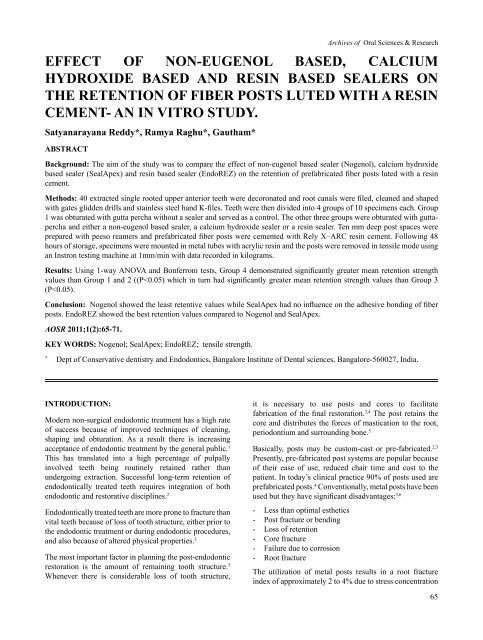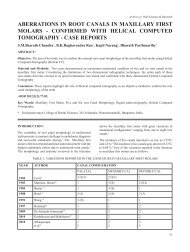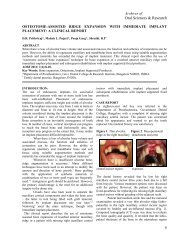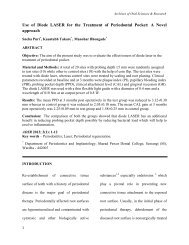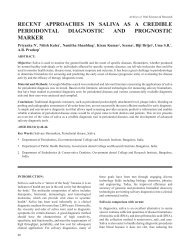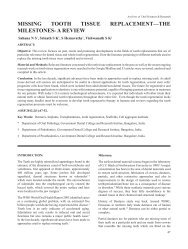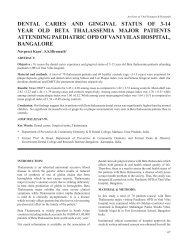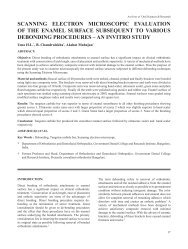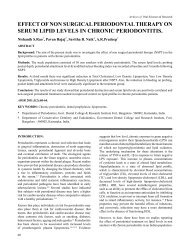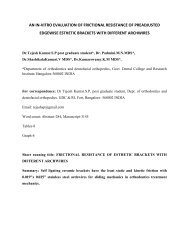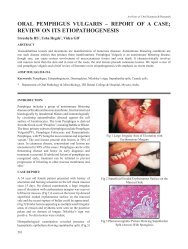effect of non-eugenol based, calcium hydroxide based and ... - AOSR
effect of non-eugenol based, calcium hydroxide based and ... - AOSR
effect of non-eugenol based, calcium hydroxide based and ... - AOSR
You also want an ePaper? Increase the reach of your titles
YUMPU automatically turns print PDFs into web optimized ePapers that Google loves.
EFFECT OF NON-EUGENOL BASED, CALCIUM<br />
HYDROXIDE BASED AND RESIN BASED SEALERS ON<br />
THE RETENTION OF FIBER POSTS LUTED WITH A RESIN<br />
CEMENT- AN IN VITRO STUDY.<br />
Satyanarayana Reddy*, Ramya Raghu*, Gautham*<br />
ABSTRACT<br />
Background: The aim <strong>of</strong> the study was to compare the <strong>effect</strong> <strong>of</strong> <strong>non</strong>-<strong>eugenol</strong> <strong>based</strong> sealer (Nogenol), <strong>calcium</strong> <strong>hydroxide</strong><br />
<strong>based</strong> sealer (SealApex) <strong>and</strong> resin <strong>based</strong> sealer (EndoREZ) on the retention <strong>of</strong> prefabricated fiber posts luted with a resin<br />
cement.<br />
Methods: 40 extracted single rooted upper anterior teeth were decoronated <strong>and</strong> root canals were filed, cleaned <strong>and</strong> shaped<br />
with gates glidden drills <strong>and</strong> stainless steel h<strong>and</strong> K-files. Teeth were then divided into 4 groups <strong>of</strong> 10 specimens each. Group<br />
1 was obturated with gutta percha without a sealer <strong>and</strong> served as a control. The other three groups were obturated with guttapercha<br />
<strong>and</strong> either a <strong>non</strong>-<strong>eugenol</strong> <strong>based</strong> sealer, a <strong>calcium</strong> <strong>hydroxide</strong> sealer or a resin sealer. Ten mm deep post spaces were<br />
prepared with peeso reamers <strong>and</strong> prefabricated fiber posts were cemented with Rely X–ARC resin cement. Following 48<br />
hours <strong>of</strong> storage, specimens were mounted in metal tubes with acrylic resin <strong>and</strong> the posts were removed in tensile mode using<br />
an Instron testing machine at 1mm/min with data recorded in kilograms.<br />
Results: Using 1-way ANOVA <strong>and</strong> Bonferroni tests, Group 4 demonstrated significantly greater mean retention strength<br />
values than Group 1 <strong>and</strong> 2 ((P
Satyanarayana Reddy et al.<br />
<strong>and</strong> this is regarded as the most severe drawback because it<br />
leads to the loss <strong>of</strong> the tooth itself. 7<br />
For all these reasons, fiber posts were developed. They<br />
demonstrate an elasticity modulus (MOE) similar to that <strong>of</strong><br />
dentin. Initially carbon fiber posts were designed, but due<br />
to their esthetic limitations they were followed by quartz<br />
fiber posts <strong>and</strong> glass fiber posts. 7<br />
In contrast to metallic posts, <strong>non</strong>-metallic tooth colored<br />
posts have several advantages: 3,6<br />
- Dentin-like shade<br />
- Physical properties <strong>and</strong> modulus <strong>of</strong> elasticity similar<br />
to that <strong>of</strong> dentin<br />
- Ability to be bonded to the radicular dentin<br />
- Easy retrieval in case <strong>of</strong> failure<br />
- Lack <strong>of</strong> corrosion<br />
Retention <strong>of</strong> the post is the major factor influencing the<br />
survival <strong>of</strong> the restoration <strong>and</strong>, to aid in this a luting cement<br />
is employed. 4 Traditionally, zinc phosphate cement has<br />
been the gold st<strong>and</strong>ard for post cementation, but studies<br />
have shown that newer resin <strong>based</strong> cements have superior<br />
properties <strong>and</strong> demonstrate significantly increased post<br />
retention when compared with zinc phosphate cement. 4<br />
It has been reported that resin-<strong>based</strong> luting cements are<br />
presently the choice <strong>of</strong> many clinicians for their strength,<br />
adhesion <strong>and</strong> ease <strong>of</strong> use. 4<br />
Many studies have compared the retention <strong>of</strong> pre-fabricated<br />
posts using different cements but not many have evaluated<br />
the <strong>effect</strong> <strong>of</strong> root canal sealers on post retention.<br />
Endodontic sealers are used in conjunction with<br />
obturating materials to serve as luting <strong>and</strong> sealing agents. 8<br />
Traditionally, sealers containing <strong>eugenol</strong> were popular,<br />
but in recent times <strong>non</strong>-<strong>eugenol</strong> <strong>based</strong> sealers are gaining<br />
popularity due to their better antimicrobial <strong>and</strong> sealing<br />
properties. 5,9 Also, they are specially useful while using<br />
resin cements for luting posts. This is because numerous<br />
studies have shown that <strong>eugenol</strong> can inhibit polymerization<br />
<strong>of</strong> resin cements. 3,10 Studies have also shown that <strong>eugenol</strong><br />
reduces the bond strength <strong>of</strong> resin cements to dentin<br />
thereby negatively influencing the retention <strong>of</strong> posts luted<br />
with resin cements. 3,5,10-12<br />
Hence, whenever resin luting cements are employed, <strong>non</strong><strong>eugenol</strong><br />
<strong>based</strong> sealers are preferred. 3,5,12<br />
Nogenol, a <strong>non</strong>-<strong>eugenol</strong> <strong>based</strong> sealer has been available<br />
for many decades now, primarily to overcome the irritating<br />
potential <strong>of</strong> <strong>eugenol</strong>. 13 It is an extension <strong>of</strong> the <strong>non</strong>-<strong>eugenol</strong><br />
periodontal dressing. Essentially, <strong>eugenol</strong> is substituted<br />
by chlorothymol <strong>and</strong> vegetable oil. 13 Calcium <strong>hydroxide</strong><br />
<strong>based</strong> sealers have been available for the past 2 decades. 13<br />
Studies have reported that they have good sealing property<br />
when compared with other sealers including the traditional<br />
66<br />
zinc oxide <strong>eugenol</strong> sealers probably due to their expansion<br />
upon setting. 5<br />
Urethane dimethacrylate (UDMA) is one <strong>of</strong> the monomers<br />
forming the organic matrix <strong>of</strong> composite resins. Recently,<br />
it has been incorporated into an endodontic resin sealer <strong>and</strong><br />
is marketed as EndoREZ. 14 This sealer is reported to be<br />
biocompatible, with hydrophilic characteristics <strong>and</strong> capable<br />
<strong>of</strong> achieving a satisfactory seal. 14,15 Also EndoREZ has<br />
demonstrated extensive penetration into dentinal tubules<br />
similar to epoxy resin sealers. 16 Due to its hydrophilic<br />
properties it can be used in slightly moist canals thereby<br />
overcoming the problem <strong>of</strong> obtaining a completely dry<br />
dentinal surface within the root canal. 14,17<br />
At present, there are not many studies reporting the<br />
influence <strong>of</strong> <strong>non</strong>-<strong>eugenol</strong> sealers like Nogenol, SealApex<br />
<strong>and</strong> EndoREZ on the retention <strong>of</strong> pre-fabricated fiber posts<br />
luted with resin cements.<br />
Hence, the purpose <strong>of</strong> this in vitro study was to compare<br />
the <strong>effect</strong> <strong>of</strong> Nogenol (<strong>non</strong>-<strong>eugenol</strong> sealer), SealApex<br />
(<strong>calcium</strong> <strong>hydroxide</strong> sealer) <strong>and</strong> EndoREZ (resin sealer) on<br />
the retention <strong>of</strong> pre-fabricated fiber posts luted with resin<br />
cement.<br />
MATERIALS AND METHODS:<br />
The details <strong>of</strong> the materials used in this study are given in<br />
Table 1. 40 human single rooted maxillary anterior teeth that<br />
were freshly extracted were used for the study. The teeth<br />
were decoronated at the cemento-enamel junction using<br />
carborundum disks rotating at slow speed in a micromotor<br />
straight h<strong>and</strong> piece. The canals were cleaned <strong>and</strong> shaped<br />
using Gates Glidden drills for coronal flaring <strong>and</strong> stainless<br />
steel h<strong>and</strong> K-files. 3% NaOCl <strong>and</strong> EDTA gel (Rc-Prep)<br />
were used during canal preparation. The size <strong>of</strong> master<br />
apical file was kept constant at 40. The final irrigation was<br />
done with 17% EDTA to remove the smear layer.<br />
The teeth were divided into 4 groups, each containing 10<br />
teeth.<br />
- Group 1 was obturated with gutta-percha without a<br />
sealer <strong>and</strong> served as a control.<br />
- Group 2 were obturated with gutta-percha <strong>and</strong> a <strong>calcium</strong><br />
<strong>hydroxide</strong> <strong>based</strong> sealer (SealApex)<br />
- Group 3 were obturated with gutta-percha <strong>and</strong> <strong>non</strong><strong>eugenol</strong><br />
<strong>based</strong> sealer (Nogenol)<br />
- Group 4 were obturated with gutta-percha <strong>and</strong> resin<br />
<strong>based</strong> sealer (EndoREZ)<br />
Post space preparation upto the coronal 10mm <strong>of</strong> each root<br />
canal using size1-4 Peeso reamers. The canals were dried<br />
followed by acid etching <strong>and</strong> application <strong>and</strong> light curing<br />
<strong>of</strong> dentin bonding agent. Rely X-ARC resin cement was<br />
used to lute the fibre posts according to the manufacturer’s<br />
instructions (Figure 1).
After this, the roots were gently notched using a<br />
carborundum disk <strong>and</strong> the specimens were mounted into<br />
1 cm diameter metal tubes using acrylic. Dental surveyor<br />
was used in mounting the specimens to enable subsequent<br />
post removal in a direction parallel to the long axis <strong>of</strong> the<br />
posts (Figure 2). A customized metal framework was made<br />
to support acrylic resin around the notches on the coronal<br />
part <strong>of</strong> the fiber posts (Figure 3). This apparatus facilitated<br />
the removal <strong>of</strong> the posts in tensile mode.<br />
The specimens were secured <strong>and</strong> the posts were extracted<br />
using vise clamps mounted in a universal testing machine<br />
(Instron machine) operated in a tensile mode at 1mm/ min<br />
until the posts were dislodged from the canals (Figure 4).<br />
Data was recorded in kilograms <strong>and</strong> subsequently examined<br />
using ANOVA <strong>and</strong> Bonferroni tests.<br />
Figure 1: Prefabricated fiber post luted into the canal<br />
Figure 2: Mounting the specimens with surveyor to<br />
ensure parallelism<br />
Non-<strong>eugenol</strong>, <strong>calcium</strong> <strong>hydroxide</strong> <strong>and</strong> resin sealers: Retention <strong>of</strong> fiber posts<br />
Table 1: List <strong>of</strong> materials used in the study<br />
Armamentarium Manufacturer<br />
Nogenol root canal sealer GC America Inc., Alsip, IL 60803<br />
SealApex Sybron Endo, Glendora, California 91740<br />
EndoRez Ultradent, South Jordan, UT 84095 USA.<br />
Rely X-ARC (A3 shade) 3M ESPE<br />
Single bond (Adper) 3M ESPE, St. Paul, MN 55144 USA<br />
Light curing unit – 2500 3M ESPE, USA<br />
17% EDTA - Rc Prep Premier dental products, Canada<br />
37% ortho phosphoric acid (H3PO4) 3M ESPE, 3M Dental products<br />
Surveyor Shin Precision industrial Co.<br />
Instron testing machine Model 5566, Instron Corp, Canton, Massachusetts, SMS,<br />
SS-35N, SAE<br />
Figure 3: Metal sleeve attached to the coronal part <strong>of</strong><br />
the fiber post.<br />
Figure 4: Post gripped using vise clamps in an Instron<br />
testing machine.<br />
RESULTS:<br />
All the specimens were subjected to tensile force using an<br />
Instron universal testing machine <strong>and</strong> the load at which<br />
fracture occurred was recorded in kilograms (kgs) as<br />
shown in Table-2. No root or post fractures occurred in any<br />
<strong>of</strong> the samples during testing. Mean tensile bond strengths<br />
<strong>of</strong> all the groups tested is presented in Table-3 along with<br />
the st<strong>and</strong>ard deviation. Visual inspection <strong>of</strong> the cemented<br />
surface <strong>of</strong> the dislodged post showed resin cement over<br />
the surface with failure appearing to occur at the root-resin<br />
cement interface. Analysis <strong>of</strong> variance technique (one-way<br />
ANOVA) was used to evaluate the difference among 4<br />
67
Satyanarayana Reddy et al.<br />
groups as shown in Table-4. Normal plot <strong>of</strong> the data on<br />
tensile bond strength indicated that the observations had<br />
come from normal distribution. Hence, to carry out test<br />
<strong>of</strong> equality <strong>of</strong> mean tensile bond strength for the four<br />
groups, Post Hoc test with multiple comparisons using<br />
Bonferroni procedure was carried out with SPSS s<strong>of</strong>tware.<br />
The test results are presented in Table-5. This gave a value<br />
<strong>of</strong> P
Table 4: One-way ANOVA test<br />
Table 5: Post Hoc Tests with multiple comparisons using Bonferroni procedure<br />
+ Suggestive significance (P value: 0.05
Satyanarayana Reddy et al.<br />
As fiber posts are a relatively recent addition to the<br />
endodontic armamentarium, there are only a few studies<br />
on the <strong>effect</strong> <strong>of</strong> sealers or their constituents on the retention<br />
<strong>of</strong> glass fiber posts luted with resin cement. In case a post<br />
is required for restoring the endodontically treated tooth,<br />
following obturation post space should be prepared by<br />
removing the core filling material <strong>and</strong> endodontic sealer<br />
from the canal walls. 15 Traditionally, <strong>eugenol</strong> <strong>based</strong><br />
sealers have been widely employed. 5 With the current shift<br />
towards using resin cements for post cementation,<br />
elimination <strong>of</strong> <strong>eugenol</strong> is important as it has considerable<br />
radical scavenging properties <strong>and</strong> inhibits composite<br />
polymerization. 5 Several researchers have reported that the<br />
presence <strong>of</strong> <strong>eugenol</strong> substantially decreased the retention<br />
<strong>of</strong> posts cemented with resin cement. 5 Thus, the general<br />
recommendation is to avoid using <strong>eugenol</strong>-containing<br />
sealers prior to bonding procedures in endodontics. 12<br />
Therefore, in the present study <strong>non</strong>-<strong>eugenol</strong> sealers such<br />
as Nogenol (<strong>non</strong>-<strong>eugenol</strong> <strong>based</strong>), SealApex (<strong>calcium</strong><br />
<strong>hydroxide</strong>) <strong>and</strong> a recently developed adhesive sealer<br />
EndoREZ (resin <strong>based</strong>) were employed. Since it is well<br />
known that <strong>eugenol</strong> inhibits the polymerization <strong>of</strong> resin<br />
cements it was assumed that the use <strong>of</strong> <strong>non</strong>-<strong>eugenol</strong> sealant 5<br />
– Nogenol would enhance the retention <strong>of</strong> fiber post. But<br />
the results <strong>of</strong> this study showed that Group III (Nogenol)<br />
showed least retention among all groups tested (17.17 ±<br />
13.59). This was even lower than Group I (Control) where<br />
no sealer was used (17.89 ± 3.72). This is in accordance<br />
with the observations <strong>of</strong> a previous study that there may be<br />
a component in Nogenol that overcomes the benefit <strong>of</strong> the<br />
<strong>non</strong>-<strong>eugenol</strong> setting mechanism. 10 Thus it may be inferred<br />
that Nogenol is not recommended as a sealer in teeth<br />
requiring pre-fabricated posts luted with resin cements. 10<br />
According to the results, Group I (Control group without<br />
sealer) showed higher mean retention strength values than<br />
even Group III (Nogenol). This suggests that the residual<br />
sealer does have a definite <strong>effect</strong> on bond strength <strong>of</strong> resin<br />
cements. This is in accordance with the study by Hagge<br />
MS et al. 12<br />
Group II (Seal Apex) performed better than both Group<br />
III (Nogenol) <strong>and</strong> Group I (Control). This is similar to the<br />
results <strong>of</strong> <strong>and</strong> Hagge MS et al. 12 This suggests that <strong>calcium</strong><br />
<strong>hydroxide</strong> sealer residue does not have any inhibitory <strong>effect</strong><br />
on the polymerization <strong>of</strong> resin cements. 12<br />
The results <strong>of</strong> the present study showed that posts luted<br />
with resin cements were most retentive when EndoREZ<br />
(Group IV) was used as the sealer. This is in accordance<br />
with the prevois study which reported higher post retention<br />
values with a resin sealer. 3 Researchers have also reported<br />
that resin sealers increased the retention <strong>of</strong> pre-fabricated<br />
fiber posts luted with resin cement. 18 They attributed this to<br />
the greater compatibility between the resin sealer <strong>and</strong> the<br />
adhesive system used for post cementation as it was not<br />
70<br />
possible to completely remove the sealer from the canal walls. 18<br />
EndoREZ is a first generation methacrylate resin <strong>based</strong><br />
root canal sealer, similar to many restorative resins. 19 It<br />
has additives to make it hydrophilic to facilitate its use in<br />
the wet environment <strong>of</strong> root canal system. 14,17 It has been<br />
reported to have good flow <strong>and</strong> penetrability into dentinal<br />
tubules thereby providing good bond strength to radicular<br />
dentin. 14,17 It may thus be postulated that some residues<br />
<strong>of</strong> this cement may have remained within dentinal tubules<br />
even after post space preparation.<br />
The resin cement used in the present study is Rely-X-ARC,<br />
a dual cure cement. 20 This is also methacrylate <strong>based</strong>. 20<br />
Previous studies 4 have revealed that this cement provides<br />
superior retention for fiber posts when compared with other<br />
resin cements. This has been attributed to its superior resin<br />
tag <strong>and</strong> hybrid layer formation <strong>and</strong> excellent wettability <strong>of</strong><br />
dentinal walls. 4 Since both, the sealer (EndoREZ) <strong>and</strong> the<br />
resin cement (Rely-X-ARC) are methacrylate <strong>based</strong>, the<br />
compatibility between them could be the major factor for<br />
maximum retention values for posts in Group IV.<br />
When fiber posts <strong>and</strong> resin luting systems are used to<br />
restore endodontically treated teeth, the adhesive bonding<br />
to dentin is <strong>based</strong> on micromechanical retention created<br />
on the demineralized surface by resin tag formation. 21 For<br />
optimal post retention it is critical to have clean canal walls<br />
free from smear layer after post space preparation. 3,22,23<br />
In this study, acid etching was done as it was part <strong>of</strong> the<br />
cementation protocol with resin cements, which could<br />
have removed the smear layer to some extent.<br />
In vitro tensile bond strength testing may not be truly<br />
representative <strong>of</strong> the highly differing intraoral conditions.<br />
At best they only provide an indication <strong>of</strong> the possible<br />
clinical performance <strong>of</strong> the materials tested. For this<br />
reason, further clinical studies are necessary to validate the<br />
findings <strong>of</strong> the present study. 3<br />
CONCLUSION:<br />
The future emphasis in endodontics will focus on obtaining<br />
a ‘monoblock’ within the root canal in which the obturating<br />
material, sealer cement, root canal dentin as well as the post<br />
<strong>and</strong> core will form a single cohesive unit. In time to come,<br />
adhesive sealers <strong>and</strong> fiber posts will become the norm.<br />
The following conclusions can be drawn from the present<br />
study:<br />
1. Presence <strong>of</strong> a sealer is bound to affect the retention<br />
<strong>of</strong> fiber posts luted with resin cement, either positively<br />
or negatively.<br />
2. Nogenol (<strong>non</strong>-<strong>eugenol</strong> <strong>based</strong> sealer) produced the least<br />
retentive values among the three tested sealers.<br />
3. SealApex (<strong>calcium</strong> <strong>hydroxide</strong> <strong>based</strong> sealer) did not<br />
influence the adhesive bonding <strong>of</strong> fiber posts.
4. EndoREZ (resin <strong>based</strong> sealer) demonstrated the<br />
highest retention values for fiber posts luted with resin<br />
cements.<br />
REFERENCES:<br />
1. Johnson J, Schwartz N, Blackwell R. Evaluation <strong>and</strong><br />
restoration <strong>of</strong> endodontically treated posterior teeth.<br />
J Am Dent Assoc. 1976;93:597-605.<br />
2. Miller WA. Post <strong>and</strong> core systems: which one is best?<br />
J Prosthet Dent. 1982;48:27-40.<br />
3. Davis ST, O’Connell BC. The <strong>effect</strong> <strong>of</strong> two root canal<br />
sealers on the retentive strength <strong>of</strong> glass fiber endodontic<br />
posts. J Oral Rehab. 2007;34:468–473.<br />
4. Sen D, Poyrazoglu E, Tuncelli B. The retentive <strong>effect</strong>s<br />
<strong>of</strong> pre-fabricated posts by luting cements. J Oral Rehab.<br />
2004;31:583–589.<br />
5. David RB, Peter CM, Neal PW, Donna AB. Effect <strong>of</strong><br />
endodontic sealers on dowels luted with resin cement.<br />
J Prosthodontics 2000;9(3):137-141<br />
6. Alison JEQ, Ch<strong>and</strong>ler NP, Purton DG. A comparison<br />
<strong>of</strong> the retention <strong>of</strong> tooth-colored posts. Quintessence<br />
Int. 2003;34(3):199–201.<br />
7. Graziela AG, Lutz FV, Renata MM, Roberto S,<br />
Marco AB. Evaluation <strong>of</strong> the flexural strength <strong>of</strong> carbon<br />
fiber, quartz fiber <strong>and</strong> glass fiber-<strong>based</strong> posts. J Endodon.<br />
2005;31(3):209-211.<br />
8. Kopper PMP, Figueiredo JAP, Della Bona A, Vanni<br />
JR, Bier CA, Bopp S. Comparative in vivo analysis<br />
<strong>of</strong> the sealing ability <strong>of</strong> three endodontic sealers in postprepared<br />
root canals. Int Endodon J. 2003;36:857-<br />
863.<br />
9. Kouvas V, Liolios E, Vassiliadis L, Parissis-Messimeris<br />
S, Boutsioukis A. Influence <strong>of</strong> smear layer on depth<br />
<strong>of</strong> penetration <strong>of</strong> three endodontic sealers: an SEM<br />
study. Endod Dent Traumatol 1998;14:191–195.<br />
10. Jack TM, Ann MW, Goldsmith LJ, Lawrence G. Effect<br />
<strong>of</strong> root canal sealer <strong>and</strong> irrigation agents on retention<br />
<strong>of</strong> preformed posts luted with a resin cement. J Endodon.<br />
2000;26(6):341-344.<br />
11. Hagge MS, Ralan DM, James SL. Effect <strong>of</strong> dowel space<br />
preparation <strong>and</strong> composite cement thickness on<br />
retention <strong>of</strong> a prefabricated dowel. J Prosthodontics<br />
2002;11(1):19-24.<br />
12. Hagge MS, Ralan DM, James SL. Effect <strong>of</strong> three root<br />
canal sealers on the retentive strength <strong>of</strong> endodontic posts<br />
luted with a resin cement. Int Endodon J. 2002;35:372–<br />
378.<br />
Non-<strong>eugenol</strong>, <strong>calcium</strong> <strong>hydroxide</strong> <strong>and</strong> resin sealers: Retention <strong>of</strong> fiber posts<br />
Correspondence:<br />
Dr. Ramya Raghu<br />
Dept <strong>of</strong> Conservative dentistry <strong>and</strong> Endodontics,<br />
Bangalore Institute <strong>of</strong> Dental sciences,<br />
5/3, Hosur road, Near Lakkas<strong>and</strong>ra Bus stop, Bangalore 560027.<br />
13. Zuhair ZAK, Robert HB, Donald RM, Cemil Y, Satish<br />
B, Lawrence MF. The antimicrobial <strong>effect</strong> <strong>of</strong> various<br />
endodontic sealers. Oral Surg Oral Med Oral Pathol.<br />
1990;70:784-790.<br />
14. Sevimay S, Kalayci A. Evaluation <strong>of</strong> apical sealing<br />
ability <strong>and</strong> adaptation to dentin <strong>of</strong> two resin-<strong>based</strong><br />
sealers. J Oral Rehab. 2005;32:105–110.<br />
15. Periera CC, Oliviera EPM, Gomes MS, Della-Bona<br />
A,Vanni JR, Kopper PMP, Fiqueiredo JAP. Comparative<br />
in vivo analysis <strong>of</strong> the sealing ability <strong>of</strong> three endodontic<br />
sealers in dog teeth after post-space preparation. Aust<br />
Endod J. 2007;33:101–106.<br />
16. Mamootil K, Messer HH. Penetration <strong>of</strong> dentinal<br />
tubules by endodontic sealer cements in extracted teeth<br />
<strong>and</strong> in vivo. Int Endodontic J. 2007;40:873–881.<br />
17. Jainaen A, Palamara JEA, Messer HH. Push-out bond<br />
strength <strong>of</strong> the dentine-sealer interface with <strong>and</strong> without<br />
a main cone. Int Endodon J. 2007;40:882–890.<br />
18. Aless<strong>and</strong>ro V, Simon G, Marco F. Comparison<br />
between two clinical procedures for bonding fiber posts<br />
into a root canal: A microscopic investigation.<br />
J Endodon. 2002;28(5):355-360.<br />
19. Brian RB, Robert JL, Thomas EB, Jason MA, Mark SC,<br />
JongryulK,YoungKK,NormanRW,DavidHP,Franklin<br />
RT. Bonding <strong>of</strong> self-adhesive (self-etching) root canal<br />
sealers to radicular dentin. J Endodon. 2009;35(4):578–<br />
582.<br />
20. Edward EH. Dental cements for definitive luting: A<br />
review <strong>and</strong> practical clinical considerations. Dent Cli<br />
North Am. 2007;51:643–658.<br />
21. Cinzia S, Giuseppe G, Enzo C, Marco F. Surface debris<br />
<strong>of</strong> canal walls after post space preparation in<br />
endodontically treated teeth: A SEM study. Oral Surg<br />
Oral Med Oral Pathol Oral Radiol Endod.<br />
2004;97(3):381–387.<br />
22. Muniz L, Mathias P. The influence <strong>of</strong> sodium<br />
hypochlorite <strong>and</strong> root canal sealers on post retention in<br />
different dentin regions. Oper Dent. 2005;30(4):533–<br />
539.<br />
23. Xin-Hua G, Cai-Yun M, Matthias K. Effect <strong>of</strong> different<br />
irrigation on smear layer removal after post space<br />
preparation. J Endodon. 2009;35(4):583–586.<br />
71


